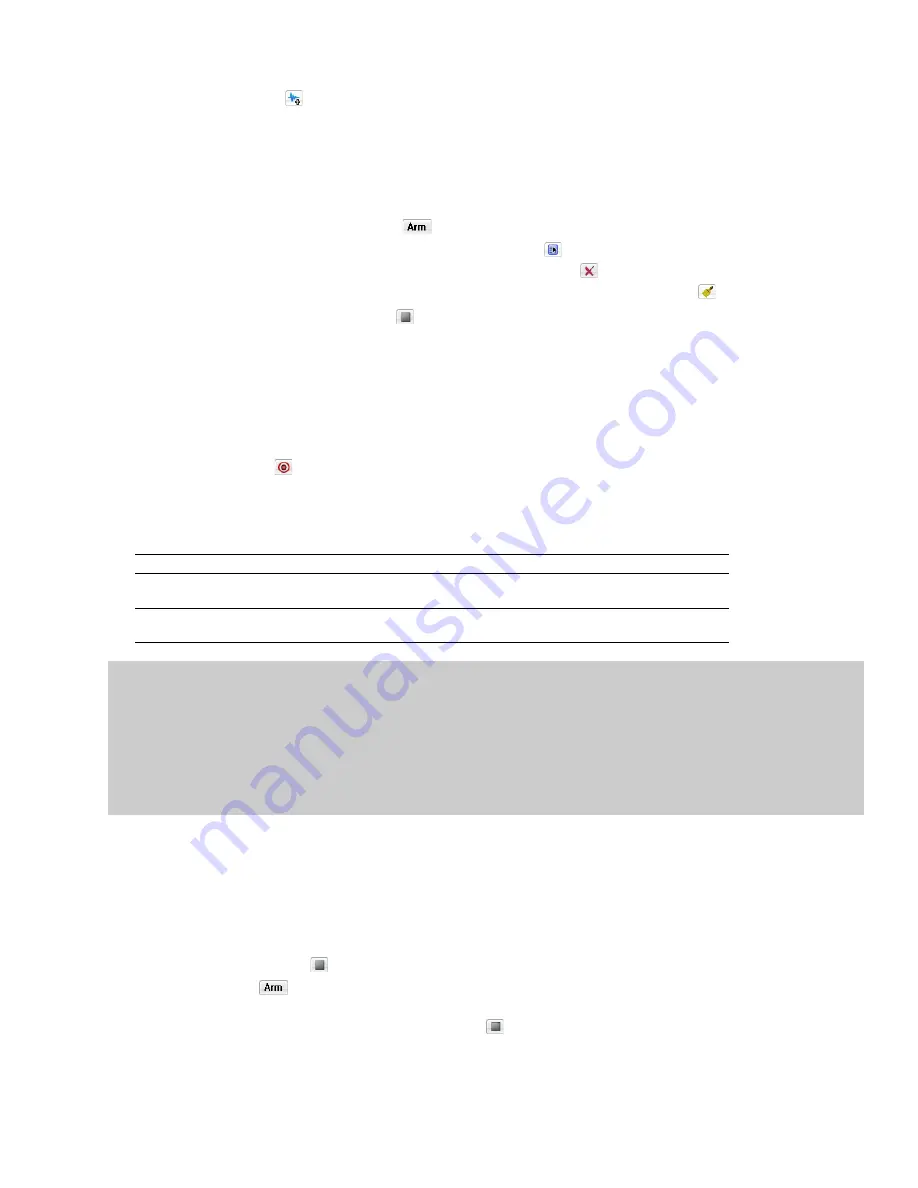
5.
Use the
Time Options
tab at the bottom of the Record dialog to set the timer:
a.
Click the
Add
button (
) to create a timer setting. The Record Timer Event dialog appears.
b.
Type a name in the
Name
field to create a name to identify the preset.
c.
Choose a setting from the
Recurrence
drop-down list to indicate whether you want to record one time only or repeat the
selected recording day and time at a regular interval.
d.
Use the
Start date
,
Start time
, and
Duration
boxes to indicate when you want to start and stop recording.
e.
Click
OK
to close the dialog and return to the Record dialog.
6.
Select a timer setting and click the
Arm
button (
) in the Record dialog when you’re ready to start the timer.
•
If you want to edit a timer setting, select it and click the
Edit
button (
) to display the Record Timer Event dialog.
•
If you want to remove a timer setting, select it and click the
Delete
button (
).
•
If you want to remove all past timer settings, click the
Remove All Past Events from List
button (
).
7.
To end timed recording, click the
Stop
button (
).
8.
Click the
Close
button to close the Record dialog.
Triggering by a set threshold
When you’re using threshold-triggered recording, you can choose to record continuously: set a buffer size, and Sound Forge software
will record to fill the buffer, discarding the oldest data as new data is recorded. If you want to save data from the buffer, you can save it to
disk.
1.
Click the
Record
button (
) on the transport bar, or press Ctrl+R. The Record dialog appears.
2.
From the
Method
drop-down list, choose
Automatic: Threshold
.
3.
Choose the destination data window for your recording. By default, the software records into the active data window. If this is not
where you want to record, use one of the following methods to prepare for recording:
If
Then
You want to record into a
Click the
Window
button and choose a data window from the
Record destination
different data window
window
drop-down list. Click
OK
to return to the Record dialog.
You want to record into a new Click the
New
button in the Record dialog and specify the attributes (sample rate, bit
window
depth, and channels) for the new file. Click
OK
to return to the Record dialog.
Note:
The maximum number of channels recorded depends on the data window where you're recording. For example, if you enabled
six inputs on the
Record
tab in Audio preferences, you need to record into a six-channel data window to record all six inputs. If you
record to a stereo data window, only two inputs will be recorded.
To route inputs to channels in the data window, click a channel number and choose a new input port from the menu.
To determine which inputs are recorded, type a value in the
Channels
box. For example, you could type
1-4
to record channels 1
through 4, or type
1, 3, 4
to record only channels 1, 3, and 4.
4.
From the
Mode
drop-down list, choose a recording mode.
5.
Use the
Threshold Options
tab at the bottom of the Record dialog to set the audio levels at which recording will start and stop:
a.
Drag the
Threshold
fader to set the audio level at which recording will begin.
b.
Drag the
Release
slider to set the amount of time the audio level should be below the
Threshold
setting before recording will
stop.
c.
Select the
Automatically rearm after record
check box if you want to continue monitoring audio levels and recording until
you click the
Stop
button (
).
6.
Click the
Arm
button (
) in the Record dialog. Recording will begin when the audio signal meets the threshold level and will
stop after the level falls below the threshold for the specified release time.
7.
To end audio monitoring and recording, click the
Stop
button (
8.
Click the
Close
button to close the Record dialog.
).
RECORDING AND EXTRACTING AUDIO
|
139
Summary of Contents for Pro 10
Page 1: ...Pro 10 Sound Forge User Manual ...
Page 2: ......
Page 26: ...20 CHAPTER 1 ...
Page 60: ...54 CHAPTER 2 ...
Page 152: ...146 CHAPTER 8 ...
Page 166: ...160 CHAPTER 9 ...
Page 176: ...170 CHAPTER 10 ...
Page 200: ...194 CHAPTER 11 ...
Page 220: ...214 CHAPTER 12 ...
Page 236: ...230 CHAPTER 13 ...
Page 266: ...260 CHAPTER 16 ...
Page 278: ...272 CHAPTER 17 ...
Page 312: ...306 CHAPTER 20 ...
Page 346: ...340 APPENDIX C ...
Page 366: ...360 APPENDIX E ...






























